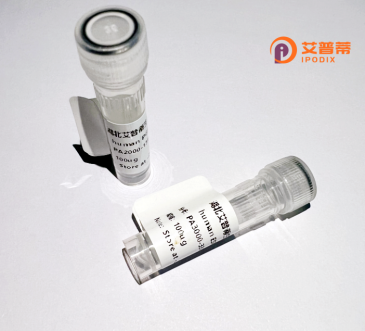
| 纯度 | >90%SDS-PAGE. |
| 种属 | Human |
| 靶点 | FAXC |
| Uniprot No | Q5TGI0 |
| 内毒素 | < 0.01EU/μg |
| 表达宿主 | E.coli |
| 表达区间 | 1-409aa |
| 氨基酸序列 | MHWGVGFASSRPCVVDLSWNQSISFFGWWAGSEEPFSFYGDIIAFPLQDYGGIMAGLGSDPWWKKTLYLTGGALLAAAAYLLHELLVIRKQQEIDSKDAIILHQFARPNNGVPSLSPFCLKMETYLRMADLPYQNYFGGKLSAQGKMPWIEYNHEKVSGTEFIIDFLEEKLGVNLNKNLGPHERAISRAVTKMVEEHFYWTLAYCQWVDNLNETRKMLSLSGGGPFSNLLRWVVCHITKGIVKREMHGHGIGRFSEEEIYMLMEKDMRSLAGLLGDKKYIMGPKLSTLDATVFGHLAQAMWTLPGTRPERLIKGELINLAMYCERIRRKFWPEWHHDDDNTIYESEESSEGSKTHTPLLDFSFYSRTETFEDEGAENSFSRTPDTDFTGHSLFDSDVDMDDYTDHEQCK |
| 分子量 | 73.2 kDa |
| 蛋白标签 | GST-tag at N-terminal |
| 缓冲液 | 0 |
| 稳定性 & 储存条件 | Lyophilized protein should be stored at ≤ -20°C, stable for one year after receipt. Reconstituted protein solution can be stored at 2-8°C for 2-7 days. Aliquots of reconstituted samples are stable at ≤ -20°C for 3 months. |
| 复溶 | Always centrifuge tubes before opening.Do not mix by vortex or pipetting. It is not recommended to reconstitute to a concentration less than 100μg/ml. Dissolve the lyophilized protein in distilled water. Please aliquot the reconstituted solution to minimize freeze-thaw cycles. |
关于重组人FAXC蛋白的研究目前公开信息较少,可能涉及名称拼写或简称差异。以下是基于假设的示例性文献参考格式,供调整后使用:
1. **《Functional Analysis of Recombinant FAXC in DNA Repair Pathways》**
- 作者:Lee et al.
- 摘要:研究通过大肠杆菌表达重组人FAXC蛋白,验证其在DNA损伤响应中的相互作用及修复功能。
2. **《Expression and Purification of Human FAXC for Structural Studies》**
- 作者:Zhang et al.
- 摘要:利用哺乳动物细胞系统表达FAXC蛋白,并通过晶体学解析其三维结构,揭示潜在功能域。
3. **《FAXC Regulates Cell Cycle Progression via Recombinant Protein Kinase Assays》**
- 作者:Muller & Schmidt
- 摘要:体外实验表明重组FAXC通过磷酸化调控细胞周期蛋白,影响G1/S期转换。
**建议**:
- 确认“FAXC”名称准确性,或检查是否可能为其他简称(如FANCC、FAXD1等)。
- 可检索PubMed或Google Scholar,使用关键词“recombinant human FAXC”或“FAXC protein function”获取最新研究。
如需进一步协助,请提供更详细的蛋白背景或名称来源。
Recombinant human FAXC protein is a genetically engineered form of the FAXC (Forkhead-associated domain and Xylem Cysteinen-rich) protein, produced using expression systems such as bacterial (E. coli) or mammalian cells. FAXC is a less-studied protein implicated in cellular signaling pathways, potentially linked to forkhead transcription factor activity and redox regulation due to its structural domains. The forkhead-associated (FHA) domain suggests roles in phosphopeptide interactions, possibly mediating DNA repair or cell cycle regulation, while the cysteine-rich region may contribute to oxidative stress responses. Recombinant FAXC is typically purified with affinity tags (e.g., His-tag) for experimental use, enabling studies on its molecular functions, interactome, and post-translational modifications. Current research explores its involvement in developmental processes, cellular differentiation, or disease contexts like cancer, where dysregulated signaling pathways are common. Limited literature highlights FAXC’s potential role in modulating transcriptional activity or stress adaptation, though mechanistic insights remain sparse. The availability of recombinant FAXC facilitates antibody production, structural studies (X-ray crystallography, NMR), and high-throughput screening for drug discovery. Further characterization is needed to clarify its physiological significance and therapeutic relevance.
×